If you’re new to the world of yoga, you might be surprised to learn that there are many different types of yoga available to you. Each type of yoga offers unique benefits and experiences, making it essential to choose the style that aligns with your goals and preferences.
Before diving in, you might be wondering, “Which type of yoga is the best for me?” The answer to this question will depend on what you want to achieve through your yoga practice. Are you looking for a way to relax and reduce stress, or are you seeking a more challenging physical workout?
In the following sections, we will explore different yoga types and help you determine which one is the best for you.
Key Takeaways
- There are many different types of yoga available, each with its own unique benefits and experiences.
- Choosing the best yoga type for you will depend on your goals and preferences.
- Some yoga styles focus on relaxation and stress relief, while others promote physical fitness and strength building.
- It’s essential to explore various yoga types to find the one that aligns with your goals and preferences.
- Don’t be afraid to try different forms of yoga to find the one that resonates with you the most.
Understanding the Diversity of Yoga
Yoga is a diverse practice that has evolved over time, resulting in numerous styles. Each yoga style has its unique approach, benefits, and focus. Understanding the different types of yoga will help you choose the one that aligns best with your needs and goals.
Some popular yoga styles are:
| Yoga Style | Description |
|---|---|
| Hatha Yoga | A gentle practice that focuses on basic postures and breathing techniques, making it perfect for beginners. |
| Vinyasa Yoga | Characterized by a continuous and dynamic flow of movements, it is ideal for those who want to improve strength, flexibility, and promote weight loss. |
| Ashtanga Yoga | A physically demanding practice that follows a set sequence of poses, focusing on strength, stamina, and flexibility, ideal for those seeking a challenging and disciplined workout. |
| Bikram Yoga | A practice performed in a heated room, ideal for improving flexibility, promoting detoxification, and increasing cardiovascular fitness. |
| Yin Yoga | A slow-paced form of yoga that targets connective tissues, promotes deep relaxation, flexibility, and stress relief. |
| Kundalini Yoga | A transformative practice that combines physical postures, breathing techniques, meditation, and chanting to awaken spiritual energy and promote emotional and physical healing. |
| Iyengar Yoga | Focusing on alignment and precision, it uses props to assist in achieving correct posture, making it ideal for those working on improving posture and stability. |
| Restorative Yoga | A nurturing practice that uses props to support the body in comfortable positions, promoting deep relaxation and healing, making it ideal for those seeking relaxation and stress relief. |
With this diversity of yoga types, you can choose the style that suits you best based on your level of experience and fitness goals.

Hatha Yoga: The Foundation
If you are new to yoga, Hatha Yoga is an excellent choice to start with. This gentle and slow-paced practice focuses on basic yoga postures and breathing techniques, making it the foundation of many other yoga styles. It is perfect for beginners and those looking for a more relaxed form of yoga.
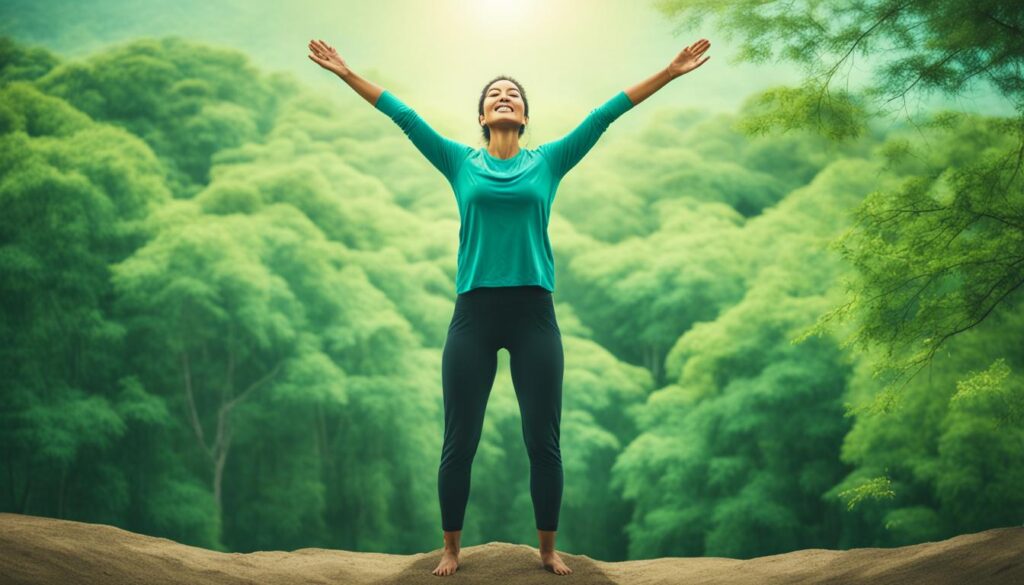
The word “Hatha” is derived from two Sanskrit terms, “Ha” meaning sun and “Tha” meaning moon. This represents the balance between opposing energies in the body, such as strength and flexibility, and effort and surrender. Hatha yoga utilizes various breathing techniques, known as pranayama, to help purify the body and calm the mind, leading to overall improved well-being.
Benefits of Hatha Yoga
Hatha Yoga has numerous benefits, including:
- Improving flexibility and balance
- Reducing stress and anxiety
- Strengthening muscles and bones
- Improving posture and alignment
Hatha yoga can also aid in managing chronic conditions such as depression, arthritis, and back pain. This style is particularly beneficial for reducing stress levels and promoting relaxation, making it a great choice for those seeking to improve their overall well-being.
Getting Started with Hatha Yoga
Practicing Hatha Yoga does not require any special equipment or clothing, making it accessible to everyone. All you need is a yoga mat and comfortable clothing that allows you to move freely. It is important to listen to your body and take things slow, especially if you are new to yoga. Remember to breathe deeply and mindfully.
“Hatha Yoga is an excellent choice for beginners and those looking for a more relaxed form of yoga.”
As you become more comfortable with the basic postures, you can gradually move on to more advanced ones and explore other types of yoga styles. To get started with Hatha yoga, consider taking a beginner’s class at your local yoga studio or following an online tutorial.
Vinyasa Yoga: Flowing Movement
If you’re looking for a form of yoga that can help you lose weight, vinyasa yoga might be the perfect fit. This dynamic and fluid practice involves continuous movements that seamlessly flow from one pose to the next.
Vinyasa yoga’s fast-paced nature and emphasis on building strength and flexibility make it a highly effective form of exercise for shedding excess weight. Additionally, the movements in vinyasa yoga are designed to increase heart rate and burn calories, making for a challenging and energizing workout.
With vinyasa yoga, you’ll be constantly moving and engaging various muscle groups throughout the body. This results in a full-body workout that promotes muscle toning and strengthens the core.
Some recommended poses for weight loss in vinyasa yoga include:
| Pose | Benefits |
|---|---|
| Chaturanga | Strengthens upper body, core, and triceps |
| Chair Pose | Tones lower body and legs |
| Warrior II | Works legs, hips, and glutes, while also toning the core |
With consistent practice, vinyasa yoga can help you achieve your weight loss goals while also improving your overall health and well-being.
Ashtanga Yoga: Traditional and Challenging
Ashtanga yoga is a fantastic choice for fitness enthusiasts seeking a disciplined, demanding practice that emphasizes strength, stamina, and flexibility.
Ashtanga is a physically demanding form of yoga that requires a consistent and focused commitment. The practice follows a rigorous set sequence of poses, each building on the previous one. The practice is done in a heated room, and practitioners move through a series of poses at a brisk pace, building heat and sweat, promoting weight loss, and increasing cardiovascular fitness.
The set sequence of poses, also known as asanas, consists of sun salutations, standing poses, seated poses, backbends, and inversions. The practice also emphasizes synchronized breathing and internal locks, known as bandhas, that help to harness and direct energy throughout the body, leading to increased strength and flexibility.
Ashtanga yoga requires focus, patience, and determination to master and is ideal for those seeking a challenging and transformative yoga experience.
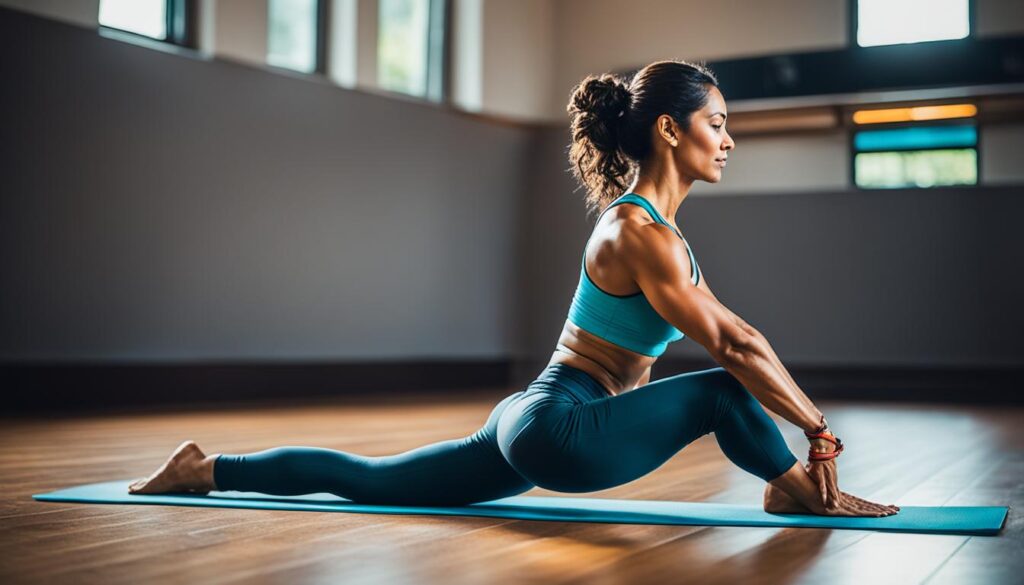
Ashtanga Yoga Benefits:
| Benefits | Description |
|---|---|
| Strength | Builds muscular strength and endurance. |
| Flexibility | Increases flexibility and range of motion in muscles and joints. |
| Cardiovascular Fitness | Increases heart rate and improves oxygenation of blood, promoting cardiovascular health. |
| Weight Loss | Ashtanga yoga is a vigorous and sweat-inducing practice that can help promote weight loss through increased calorie burn. |
| Stress Relief | Synchronized breathing and intense focus help to calm the mind and reduce stress and anxiety. |
Bikram Yoga: Heat and Intensity
Bikram yoga, also known as hot yoga, is a style of yoga that is practiced in a room heated to around 105°F (40.6°C) with high humidity. During a typical Bikram yoga class, you will perform a sequence of 26 postures and two breathing exercises, each held for a specific amount of time.
The heat and intensity of Bikram yoga provide numerous benefits for both your body and mind. One of the primary benefits is increased flexibility. The warmth of the room allows your muscles to stretch deeper, helping you achieve a greater range of motion.
In addition to flexibility, the heat and sweating in Bikram yoga promote detoxification, flushing toxins out of your body. This can have a positive impact on your skin, respiratory system, and overall health.
Bikram yoga also offers cardiovascular benefits. The intense heat and physical demands of the practice increase your heart rate and promote cardiovascular fitness.
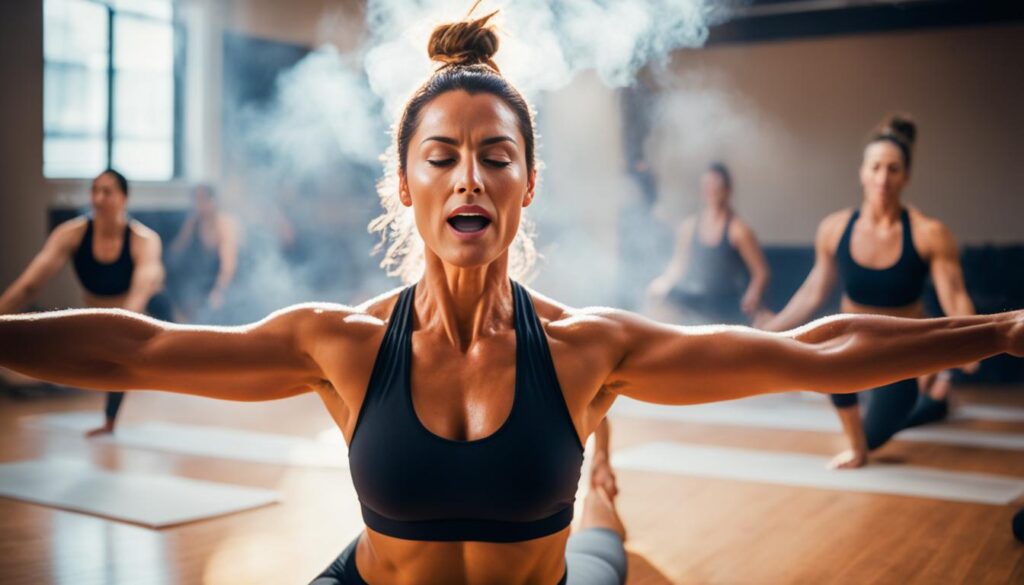
The Benefits of Bikram Yoga:
| Benefits of Bikram Yoga | Description |
|---|---|
| Increased Flexibility | The heat allows your muscles to stretch deeper, promoting a greater range of motion. |
| Detoxification | The heat and sweating promote detoxification, flushing toxins out of your body. |
| Cardiovascular Fitness | The intense heat and physical demands of the practice increase your heart rate and promote cardiovascular fitness. |
If you are considering Bikram yoga, it is essential to stay hydrated during and after the practice. Additionally, if you have any medical conditions or concerns, consult with your doctor before trying this or any other form of intense exercise.
Yin Yoga: Deep Stretching and Relaxation
If you’re looking for a relaxing yoga practice that focuses on stress relief, flexibility, and deep stretching, then yin yoga might be perfect for you. Unlike other yoga styles that emphasize movement and flow, in yin yoga, you will hold poses for an extended period.
Yin yoga poses are typically seated or lying down, and each pose is held for 3-5 minutes or longer. By holding the poses for an extended period, you are targeting the connective tissues in your body, such as tendons, ligaments, and fascia. This can lead to increased flexibility and range of motion.
Additionally, the slow-paced nature of yin yoga helps promote deep relaxation and stress relief. By holding poses for an extended period, you can access a deeper state of relaxation and calmness.
Yin yoga is suitable for all levels, from beginners to advanced practitioners. It is particularly beneficial for those with a sedentary lifestyle or those recovering from an injury. It helps improve circulation, reduce tension, and increase flexibility.
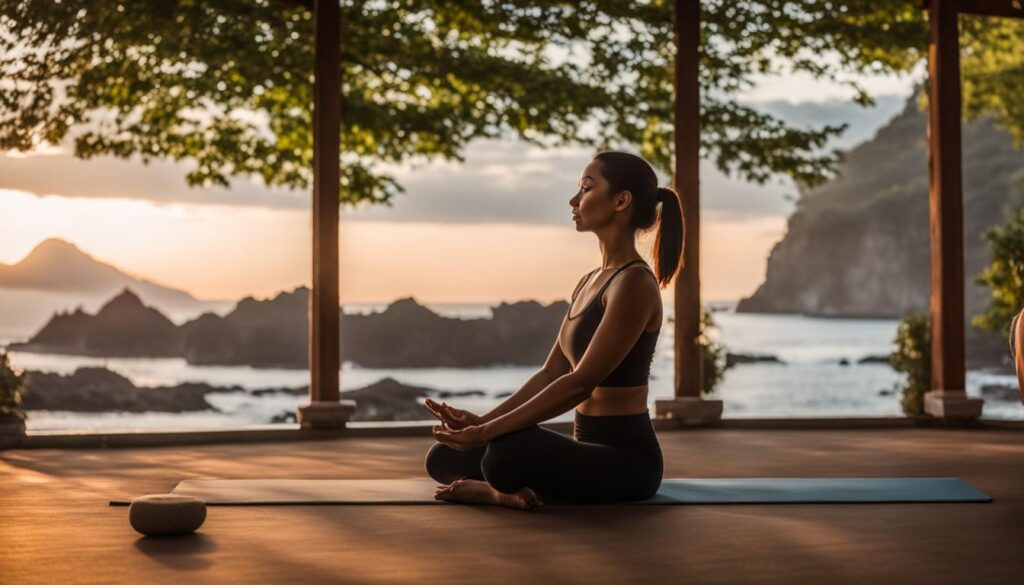
If you want to try yin yoga, start with a beginner’s class or find a video online that suits your level.
Kundalini Yoga: Spiritual Awakening
Kundalini yoga is a transformative practice that focuses on spiritual growth. It combines physical postures, breathing techniques, meditation, and mantra chanting to awaken the spiritual energy within you. Kundalini yoga can help you connect with your inner self, unlock your potential, and achieve a state of heightened awareness and consciousness.
During a Kundalini yoga session, you will perform a series of postures known as kriyas, which are designed to balance your energy and release any blockages. These postures are often dynamic and vigorous, and they may be accompanied by specific breathing techniques and chanting.
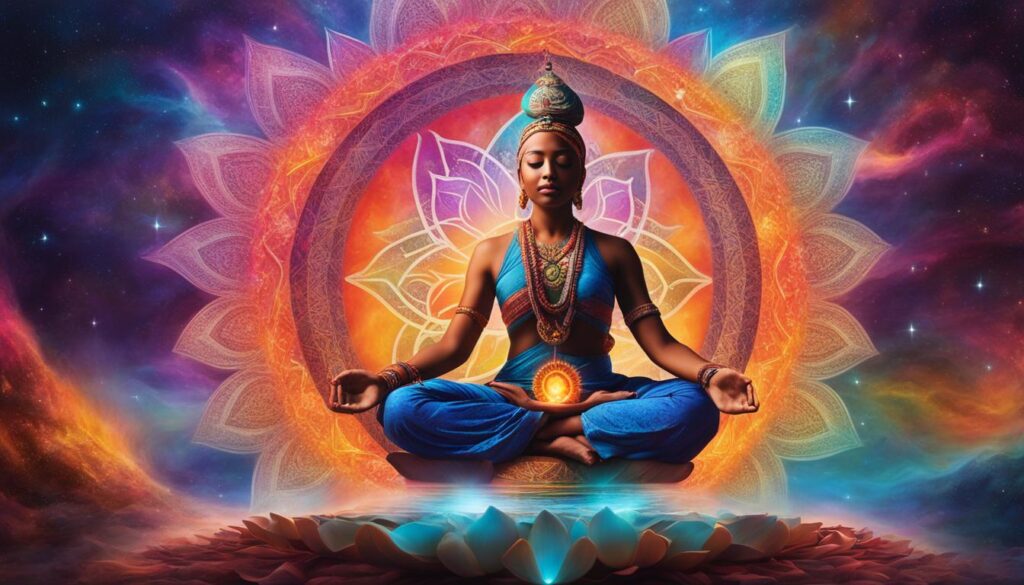
Kundalini yoga is known for its transformative and uplifting effects on the body, mind, and spirit. It can help you develop greater self-awareness, strengthen your intuition, and promote emotional healing and balance. Many people also find that Kundalini yoga enhances their creativity and productivity.
If you are interested in exploring Kundalini yoga, it is important to find a qualified instructor who can guide you through the practice. Kundalini yoga is suitable for all levels, but it is important to be mindful of your body and any limitations you may have.
Iyengar Yoga: Precision and Alignment
If you’re looking to improve your posture and alignment, Iyengar yoga is the perfect choice for you. This style emphasizes precise alignment in each pose and uses props like blocks, straps, and blankets to assist in achieving proper form.
By maintaining correct alignment during your practice, you can improve your strength, stability, and posture over time. Props like blocks and straps are especially useful for those with limited flexibility or injuries, allowing them to modify poses and receive the benefits of the practice.
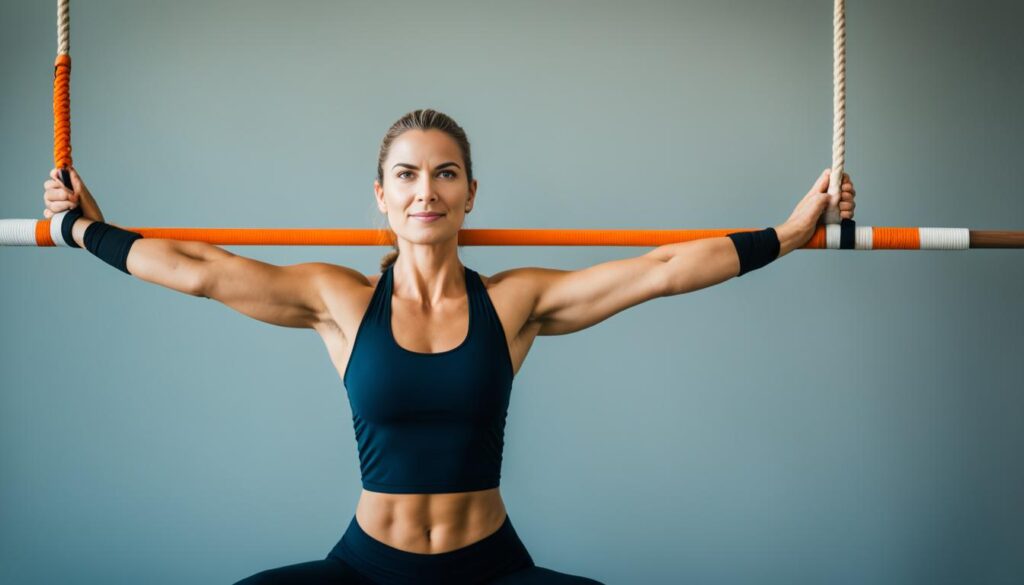
Iyengar yoga is also a great way to build awareness of your body and pinpoint areas that may need extra attention. By focusing on precision and alignment, you can identify and correct imbalances or weaknesses in your muscles.
Overall, Iyengar yoga is a fantastic choice for anyone looking to improve their posture, alignment, and overall physical well-being.
Restorative Yoga: Nurturing and Healing
Restorative yoga is a gentle and nurturing practice that uses props like blankets, blocks, and straps to support the body in comfortable positions. It is a deeply relaxing practice that promotes healing and reduces stress, anxiety, and tension.
Through restorative yoga, you can release physical and mental tension, promoting calmness and tranquility. The poses are held for longer periods, allowing for deeper stretches and increased flexibility. This practice is ideal for those who need to slow down and connect with their inner selves.
Restorative yoga has significant benefits, including reducing muscle tension, improving sleep quality, and strengthening the immune system. It is an excellent choice for those experiencing chronic pain or recovering from injuries.
When practicing restorative yoga, it is essential to let go of any expectations and allow the body to relax fully. Listen to your body and only move as far as feels comfortable. The props will help you find the perfect position to relax and receive the healing effects of the practice.
Conclusion
Now that you have a better understanding of the various types of yoga and their benefits, it’s time to choose the one that best suits your needs and preferences. Whether you’re looking for a gentle and relaxing practice like Hatha yoga, a challenging and disciplined practice like Ashtanga, or a spiritual awakening like Kundalini, there’s a yoga style that’s perfect for you.
Remember, yoga is a personal journey, and what works for others may not work for you. So take your time, try different styles, and find the one that aligns with your goals and lifestyle. With regular practice, you’ll soon experience the numerous benefits of yoga, including increased flexibility, strength, and peace of mind.
Start your yoga journey today and discover the transformative effects of this ancient practice on your mind, body and soul.
FAQ
Are there different types of yoga, and which one is best for you?
Yes, there are different types of yoga, each with its own focus and benefits. The best yoga for you depends on your goals and preferences. It’s important to try different types and see which one resonates with you the most.
What are the different types of yoga?
There are various types of yoga, including Hatha Yoga, Vinyasa Yoga, Ashtanga Yoga, Bikram Yoga, Yin Yoga, Kundalini Yoga, Iyengar Yoga, and Restorative Yoga. Each type has its own unique characteristics and benefits.
What is Hatha Yoga?
Hatha yoga is a gentle and slow-paced practice that focuses on basic yoga postures and breathing techniques. It is a great choice for beginners and those looking for a more relaxed form of yoga.
What is Vinyasa Yoga?
Vinyasa yoga is characterized by its dynamic and continuous flow of movements. It is known for building strength, flexibility, and promoting weight loss through its fast-paced nature.
What is Ashtanga Yoga?
Ashtanga yoga is a physically demanding practice that follows a set sequence of poses. It focuses on strength, stamina, and flexibility, making it ideal for those looking for a challenging and disciplined practice.
What is Bikram Yoga?
Bikram yoga is performed in a room heated to around 105°F (40.6°C) with high humidity. This intense practice promotes flexibility, detoxification, and increased cardiovascular fitness.
What is Yin Yoga?
Yin yoga is a slow-paced style that involves holding poses for an extended period, typically targeting the connective tissues and promoting deep relaxation, flexibility, and stress relief.
What is Kundalini Yoga?
Kundalini yoga combines physical postures, breathing techniques, meditation, and mantra chanting to awaken the spiritual energy within. It is known for its transformative and uplifting effects.
What is Iyengar Yoga?
Iyengar yoga focuses on precise alignment and uses props like blocks, straps, and blankets to assist in achieving correct posture. It is beneficial for improving strength, stability, and posture.
What is Restorative Yoga?
Restorative yoga uses props to support the body in comfortable positions, allowing for deep relaxation and healing. It is particularly beneficial for reducing stress, anxiety, and promoting overall well-being.
How do I choose the best type of yoga for me?
To choose the best type of yoga for you, consider your goals, fitness level, and personal preferences. Try different classes or styles to see what resonates with you the most. Consulting with a qualified yoga instructor can also provide guidance tailored to your needs.


Leave a Comment